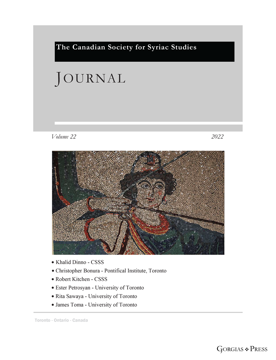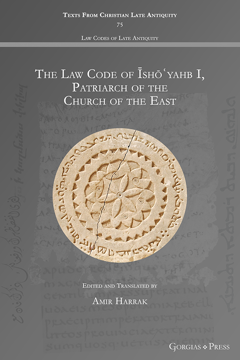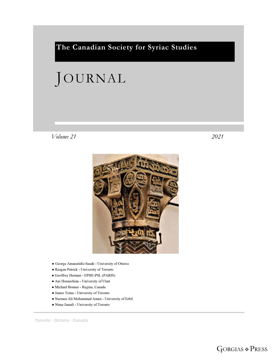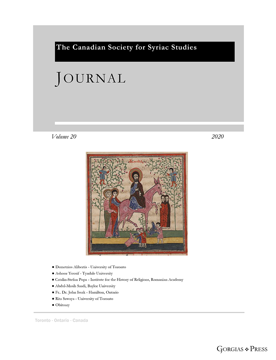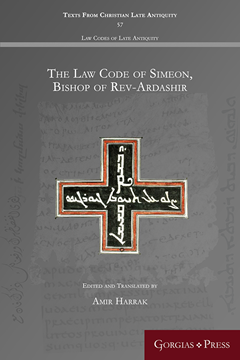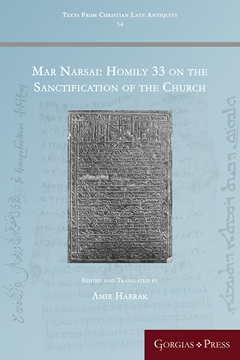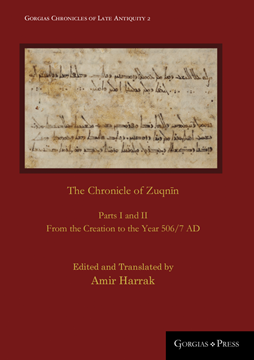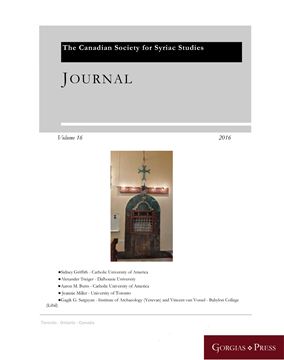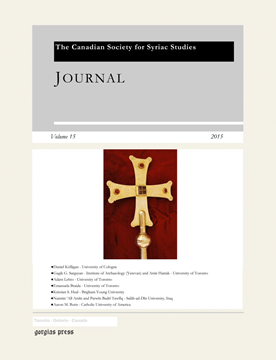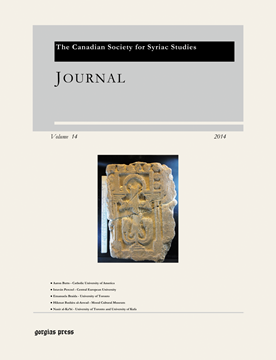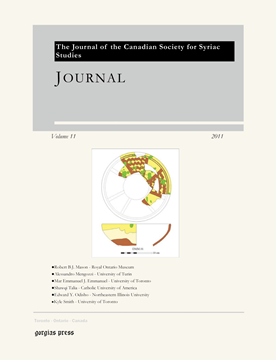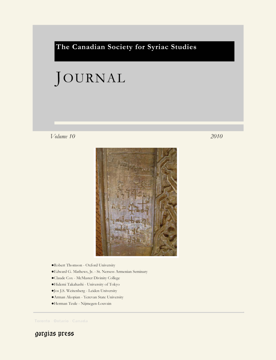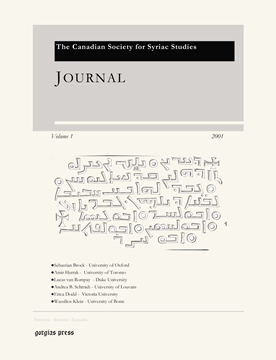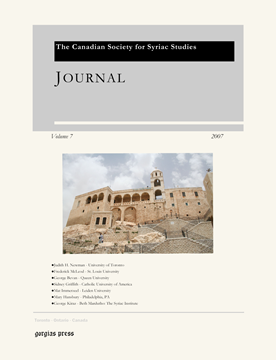Amir Harrak

Amir Harrak is full professor at the University of Toronto. His specialty is Aramaic and Syriac languages and literatures. His many publications deal with Syriac epigraphy, chronography, and cataloguing of manuscripts.
Journal of the Canadian Society for Syriac Studies 23
Edited by Amir Harrak
ISBN: 978-1-4632-4619-8
A refereed journal published annually by the Canadian Society for Syriac Studies.
$75.00 (USD) $60.00 (USD)
Journal of the Canadian Society for Syriac Studies 22
Edited by Amir Harrak
ISBN: 978-1-4632-4491-0
A refereed journal published annually by the Canadian Society for Syriac Studies.
$75.00 (USD) $60.00 (USD)
The Law Code of Īshōʿyahb I, Patriarch of the Church of the East
Edited and Translated by Amir Harrak
Series: Texts from Christian Late Antiquity 75
ISBN: 978-1-4632-4434-7
During the 6th century AD, Īshōʿyahb I, Patriarch of the Church of the East, produced a code of law dealing with questions raised by Bishop Jacob of Darai in the Gulf. Perennial Church issues include priestly conducts, ecclesiastical rankings, and ordinations. Legal matters for the faithful concern wills, marriages, vows, lending at interest, and swearing. Most interesting are names of church architecture that the Code gives, including bema, diaconicon, and qestroma, terms that are still used today.
$39.00 (USD)
Journal of the Canadian Society for Syriac Studies 21
Edited by Amir Harrak
ISBN: 978-1-4632-4396-8
A refereed journal published annually by the Canadian Society for Syriac Studies.
$75.00 (USD)
Journal of the Canadian Society for Syriac Studies 20
Edited by Amir Harrak
ISBN: 978-1-4632-4262-6
A refereed journal published annually by the Canadian Society for Syriac Studies.
$75.00 (USD)
The Law Code of Simeon, Bishop of Rev-Ardashir
Edited and Translated by Amir Harrak
Series: Texts from Christian Late Antiquity 57
ISBN: 978-1-4632-4134-6
The Law Code of Simeon of Rev-Ardashir, originally written in Persian, was translated into Syriac by a monk of Bēṭ-Qatrāyē. The Code's author, possibly to be identified with a rebellious metropolitan mentioned in the letters of Patriarch Īšoʿ-yahb III, aims to clarify theoretical scriptural law, and to address specific cases of inheritance law.
$48.40 (USD)
Journal of the Canadian Society for Syriac Studies 19
ISBN: 978-1-4632-4111-7
A refereed journal published annually by the Canadian Society for Syriac Studies.
$75.00 (USD)
The Chronicle of Michael the Great (The Edessa-Aleppo Syriac Codex)
Books XV–XXI. From the Year 1050 to 1195 AD
Edited and Translated by Amir Harrak
Series: Gorgias Chronicles of Late Antiquity 3
ISBN: 978-1-4632-4031-8
Michael the Great was elected patriarch of the Syriac Orthodox church in a most instable period. He nevertheless, found time, clarity of mind, and determination to write a voluminous world chronicle, which he completed four years before he died in November 7, 1199. The present edition and its translation begin with Book XV and end with Book XXI, the last Book in the Chronicle, thereby covering more than 160 years, from AD 1031 to AD 1195.
$215.00 (USD)
Homily 33 on the Sanctification of the Church
Edited and Translated by Amir Harrak
Series: Texts from Christian Late Antiquity 54
ISBN: 978-1-4632-0552-2
Narsai’s memra 33 is made of 12 by 12 syllables, and its title “On the Sanctification of the Church” suggests that it was written for the feast of the Dedication of the Church celebrated by the Church of the East to this day on the first of November. The memra names the Church of the Nations the Bride of the Bridegroom Christ. The Church had a pagan origin but Christ chose her to become his bride. He thus saved her through his suffering, cleansed her with baptism, prepared the bridal feast for her through the Eucharist, and crowned her victory over all the nations.
$53.00 (USD)
Journal of the Canadian Society for Syriac Studies 18
ISBN: 978-1-4632-0756-4
A refereed journal published annually by the Canadian Society for Syriac Studies.
$75.00 (USD)
Journal of the Canadian Society for Syriac Studies 17
Edited by Amir Harrak
ISBN: 978-1-4632-0740-3
A refereed journal published annually by the Canadian Society for Syriac Studies. This volume includes articles by Robert Kitchen, Khalid Dinno, Nima Jamali, Amir Harrak, Vincent van Vossel and Tala Jarjour.
$75.00 (USD)
The Chronicle of Zuqnīn
Parts I and II. From the Creation to the Year 506/7 AD
Edited and Translated by Amir Harrak
Series: Gorgias Chronicles of Late Antiquity 2
ISBN: 978-1-4632-0663-5
The Chronicle of Zuqnin is a universal history beginning with the Creation according to the biblical account and ending with the time of the Chronicler, the years 775-776 AD. The author is most probably Joshua the Stylite, a contemporary of the Caliphs al-Mansur and al-Mahdi, who lived in the monastery of Zuqnin that was located near Amid, the Diar-Bakr of modern Turkey. Parts I and II contain compiled sources some of which survived only in this Chronicle. Sources include the Bible, Cave of Treasures, the Sleepers of Ephesus, Eusebius of Caesarea, Socrates, and the short Chronicle called Pseudo-Joshua the Stylite that deals with Sassanian-Byzantine warfare at the begging of the 6th century. Parts III and IV cover the years 488 and 775 AD. In this volume, Parts I and II, including the author’s dedicatory letter, are now published in an updated edition of the Syriac text and the first English translation.
$215.00 (USD)
Journal of the Canadian Society for Syriac Studies 16
Edited by Amir Harrak
ISBN: 978-1-4632-0655-0
A refereed journal published annually by the Canadian Society for Syriac Studies. This volume includes articles by Sidney Griffith, Alexander Treiger, Aaron M. Butts, Jeanie Miller, Gagik G. Sargsyan and Vincent van Vossel.
$75.00 (USD)
Journal of the Canadian Society for Syriac Studies 15
Edited by Amir Harrak
ISBN: 978-1-4632-0569-0
A refereed journal published annually by the Canadian Society for Syriac Studies. This volume includes articles by Daniel Kolligan, Gagik G. Sargsyan, Adam Lehto, Emanuela Braida, Kristian Heal, Narmin 'Ali Amin and Parwan Badri Tawfiq, and Aaron Butts.
$75.00 (USD)
Journal of the Canadian Society for Syriac Studies 14
Edited by Amir Harrak
ISBN: 978-1-4632-0469-3
A refereed journal published annually by the Canadian Society for Syriac Studies. Volume 14 includes articles by Aaron Butts, Istvan Perczel, Emanuela Braida, Hikmat Bashir al-Aswad, and Nasir al-Ka'bi.
$75.00 (USD)
Journal of the Canadian Society for Syriac Studies 13
Edited by Amir Harrak
ISBN: 978-1-4632-0244-6
Volume 13 includes articles by Mark Dickens, Pier Giorgio Borbone, Nicholas Al-Jeloo, Emanuela Braida, Khairy Foumia, Rima Smine, Khalid Dinno and Amir Harrak.
$75.00 (USD)
Jacob of Sarug’s Homily on the Partaking of the Holy Mysteries
Translation and Introduction by Amir Harrak
Series: Texts from Christian Late Antiquity 19
ISBN: 978-1-60724-086-0
This edition of Mar Jacob of Sarug's (d. 521) homily on Partaking in the Holy Mysteries is one of Jacob’s memre on the sacraments. In this homily, Jacob is shocked that some of his congregants are leaving the service early, before the eucharist has been celebrated. He emphasizes the importance of the liturgical celebrations for a Christian life in a message still applicable today. The volume constitutes a fascicle of The Metrical Homilies of Mar Jacob of Sarug, which, when complete, will contain the original Syriac text of Jacob's surviving sermons, fully vocalized, alongside an annotated English translation.
$31.00 (USD)
Journal of the Canadian Society for Syriac Studies 12
Edited by Amir Harrak
ISBN: 978-1-4632-0216-3
Volume 12 includes articles by Françoise Briquel Chatonnet, Kyle Smith, Adam Lehto, Mar Awa David Royel, Bernard Heyberger, Nasir al-Kaʿbi, Amir Harrak and Khalid Dinno.
$75.00 (USD)
Journal of the Canadian Society for Syriac Studies 12
Edited by Amir Harrak
ISBN: 978-1-4632-0216-3
Volume 12 includes articles by Françoise Briquel Chatonnet, Kyle Smith, Adam Lehto, Mar Awa David Royel, Bernard Heyberger, Nasir al-Kaʿbi, Amir Harrak and Khalid Dinno.
$75.00 (USD)
The Syriac Orthodox Celebration of the Eucharist in Light of Jacob of Serugh’s Mimro 95
By Amir Harrak
Series: Analecta Gorgiana 1046
ISBN: 978-1-4632-0094-7
Jacob of Serugh's “Mimro 95” details the significance of the Eucharist and spiritual benefit for participants. Harrak divides verses of this commentary in order to relate stages of liturgy within the Pre-Anaphoric and Anaphoric services of 6th century Syriac worship.
$36.00 (USD)
Journal of the Canadian Society for Syriac Studies 11
Edited by Amir Harrak
ISBN: 978-1-4632-0153-1
Volume 11 includes articles by Robert Mason, Alessandro Mengozzi, Mar Emmanuel J. Emmanuel, Shawqi Talia, Edward Odisho, and Kyle Smith and is archaeology and Neo-Aramaic.
$75.00 (USD)
Journal of the Canadian Society for Syriac Studies 10
Edited by Amir Harrak
ISBN: 978-1-61143-671-6
Volume 10 includes articles by Robert Thomson, Edward G. Mathews Jr., Claude Cox, Hidemi Takahashi and Jos J.S. Weitenberg, and Arman Akopian. It is on Syriac-Armenian topics.
$75.00 (USD)
Journal of the Canadian Society for Syriac Studies 1
ISBN: 978-1-60724-066-2
The JCSSS is an annual refereed journal containing the transcripts of public lectures presented at the Canadian Society for Syriac Studies Inc. It focuses on the literature, art, and archaeology of Syriac Christianity from the 2nd century to modern times. Contributors include Sebastian Brock, Amir Harrak, Lucas van Rompay, Andrea B. Schmidt, Erica C. Dodd, and Wassilios Klein.
$75.00 (USD)
Journal of the Canadian Society for Syriac Studies 7
ISBN: 978-1-60724-060-0
The JCSSS is an annual refereed journal containing the transcripts of public lectures presented at the Canadian Society for Syriac Studies Inc. It focuses on the literature, art, and archaeology of Syriac Christianity from the 2nd century to modern times. Contributors include Judith H. Newman, Frederick McLeod, George Bevan, Sidney H. Griffith, Mat Immerzeel, Mary Hansbury, and George Kiraz.
$75.00 (USD)
Journal of the Canadian Society for Syriac Studies 9
Edited by Amir Harrak
ISBN: 978-1-60724-686-2
Volume 9 includes articles by Alexander Treiger, Mark Dickens, Emmanuel Joseph Mar-Emmanuel, Khalid Dinno and Amir Harrak, and Martin Tamcke.
$75.00 (USD)
- 1
- 2


